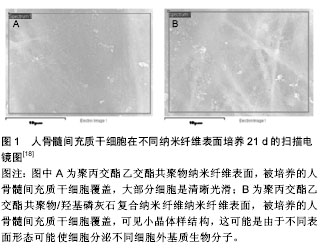| [1] Gupta B,Revagade N,Hilborn J.Poly(lactic acid) fiber: an overview. Prog Polym Sci.2007;32(4): 455-482.[2] Vasir JK,Labhasetwar V.Biodegradable nanoparticles for cytosolic delivery of therapeutics. Adv Drug Deliver Rev. 2007; 59(8):718-728.[3] Gunatillake PA,Adhikari R.Biodegradable synthetic polymers for tissue engineering.Eur Cell Mater.2003;5(1):1-16.[4] Lasprilla AJR,Martinez GAR,Lunelli BH,et al.Poly-lactic acid synthesis for application in biomedical devices-A review. Biotechnol Adv.2012;30(1):321-328.[5] Rasal RM,Janorkar AV,Hirt DE.Poly(lactic acid) modifications. Prog Polym Sci.2010;35(3):338-356.[6] Anderson JM.Biological responses to materials.Ann Rev Mater Res:2001;31(1):81-110.[7] Williams DF.On the mechanisms of biocompatibility. Biomaterials. 2008;29(20):2941-2953.[8] Dhar S,Kolishetti N,Lippard SJ,et al.Targeted delivery of a cisplatin prodrug for safer and more effective prostate cancer therapy in vivo.Proc Natl Acad Sci.2011;108(5):1850-1855.[9] Yamaguchi K,Anderson JM.Biocompatibility studies of naltrexone sustained release formulations.J Control Release. 1992;19:299-314.[10] Anderson JM,Shive MS.Biodegradation and biocompatibility of PLA and PLGA microspheres.Adv Drug Deliver Rev. 2012; 64:72-82.[11] Tyler B,Gullotti D,Mangraviti A,et al.Polylactic acid(PLA) controlled delivery carriers for biomedical applications.Adv Drug Deliv Rev. 2016;107:163-175. [12] Evans NT,Irvin CW,Safranski DL,et al.Impact of surface porosity and topography on the mechanical behavior of high strength biomedical polymers.J Mech Behav Biomed. 2016; 59:459-473.[13] Boccafoschi F,Mosca C,Cannas M.Cardiovascular biomaterials: when the inflammatory response helps to efficiently restore tissue functionality.J Tissue Eng Regen M. 2014;8(4):253-267.[14] Thompson SM,Fung S,Wood DG.The natural history of biointerference screw cyst and new bone formation in anterior cruciate ligament reconstruction 16-Year follow-up.Am J Sport Med.2016;44(1):113-117.[15] Athwal GS,Shridharani SM,O'Driscoll SW.Osteolysis and arthropathy of the shoulder after use of bioabsorbable knotless suture anchors.J Bone Joint Surg. 2006;88(8):1840-1845.[16] Boden RA,Burgess E,Enion D,et al.Use of bioabsorbable knotless suture anchors and associated accelerated shoulder arthropathy report of 3 cases.Am J Sport Med.2009;37(7): 1429-1433.[17] McCarty LP,Buss DD,Datta MW,et al.Complications observed following labral or rotator cuff repair with use of poly-L-lactic acid implants.J Bone Joint Surg Am.2013;95(6):507-511.[18] Lee JH,Rim NG,Jung HS,et al.Control of osteogenic differentiation and mineralization of human mesenchymal stem cells on composite nanofibers containing poly [lactic-co-(glycolic acid)] and hydroxyapatite.Macromol Biosci. 2010;10(2):173-182.[19] Lou T,Wang X,Song G,et al.Fabrication of PLLA/β-TCP nanocomposite scaffolds with hierarchical porosity for bone tissue engineering.Int J Biol Macromol.2014;69:464-470.[20] Dai J,Bai J,Jin J,et al.Stimulation by pearl of mineralization and biocompatibility of PLA.Adv Eng Mater.2015;17(11):1691-1697.[21] Rotunda AM,Narins RS.Poly-L-lactic acid: a new dimension in soft tissue augmentation.Dermatol Ther.2006;19(3):151-158.[22] Jones D.Volumizing the face with soft tissue fillers.Clin Plast Surg.2011;38(3):379-390.[23] Vleggaar D.Soft-tissue augmentation and the role of poly-L-lactic acid.Plast Reconstr Surg.2006; 118(3S):46S-54S.[24] Shahrabi-Farahani S,Lerman MA,Noonan V,et al. Granulomatous foreign body reaction to dermal cosmetic fillers with intraoral migration.Oral Surg Oral Med Oral Pathol Oral Radiol. 2014;117(1):105-110.[25] Malzone MG,Campanile AC,Gioioso A,et al.Silicone lymphadenopathy: Presentation of a further case containing asteroid bodies on fine-needle cytology sample.Diagn Cytopathol.2015;43(1):57-59.[26] Jagdeo J,Ho D,Lo A,et al.A systematic review of filler agents for aesthetic treatment of HIV facial lipoatrophy (FLA).J Am Acad Dermatol.2015;73(6):1040-1054.[27] No YA,Seok J,Hyun MY,et al.Long-Term(24-Month) Safety Evaluation of Poly-DL-Lactic Acid Filler Injection for the Nasolabial Fold: A Multicenter, Open, Randomized, Evaluator-Blind, Active-Controlled Design.Plast Reconstr Surg.2015;135(6):1074e-1075e.[28] Lewitus DY,Smith KL,Shain W,et al.The fate of ultrafast degrading polymeric implants in the brain. Biomaterials. 2011;32(24):5543-5550.[29] Hara K,Tsujimoto H,Tsukada Y,et al.Histological examination of PLGA nanospheres for intratracheal drug administration.Int J Pharmaceut.2008;356(1):267-273.[30] Cantin M,Miranda P,Galdames IS,et al.In vivo biocompatibility of the PLGA microparticles in parotid gland.Int J Clin Exp Patho. 2013;6(11):2412-2412.[31] Rong X,Yuan W,Lu Y,et al.Safety evaluation of poly (lactic-co-glycolic acid)/poly (lactic-acid) microspheres through intravitreal injection in rabbits.Int J Nanomed. 2014;9: 3057-3057.[32] Manna S,Banerjee RK,Augsburger JJ,et al.Biodegradable chitosan and polylactic acid-based intraocular micro-implant for sustained release of methotrexate into vitreous: analysis of pharmacokinetics and toxicity in rabbit eyes.Graef Arch Clin Exp.2015;253(8):1297-1305.[33] Ensari N,Tutar H,Ekinci O,et al.Effects of polylactic acid film on middle ear mucosa and cochlear function in Guinea pigs.Eur Arch Otorhinolaryngol.2015;272(5):1091-1097.[34] Peltonen LI,Jero J,Sukura A,et al.Biocompatibility of polylactides in the middle ear: an experimental animal study.Otol Neurotol.2007;28(6):850-853.[35] Garcia LB,Junior C,da Silva A,et al.Tissue response evaluation of the mucosa of the tympanic cavity of guinea pigs, when receiving biodegradable implant.Acta Cir Bras. 2014;29: 12-18.[36] Lee SH,Ko K,Choo MS,et al.The effect and safety of polylactic acid and adipose-derived stromal vascular fraction cell as an injectable bulking agent in urologic field: A 24-week follow-up study. J Biomed Mater Res B.2015;103(2):440-447.[37] Kotsar A,Isotalo T,Mikkonen J,et al.A new biodegradable braided self-expandable PLGA prostatic stent: an experimental study in the rabbit.J Endourol. 2008;22(5): 1065-1070.[38] Pan CJ,Tang JJ,Weng YJ,et al.Preparation, characterization and anticoagulation of curcumin-eluting controlled biodegradable coating stents.J Control Release. 2006;116(1): 42-49.[39] Yang YL,Chang CH,Huang CC,et al.Osteogenic activity of nanonized pearl powder/poly (lactide-co-glycolide) composite scaffolds for bone tissue engineering.Bio Med Mater Eng. 2014; 24(1): 979-985.[40] Durand E, Sharkawi T, Leclerc G, et al. Head-to-head comparison of a drug-free early programmed dismantling polylactic acid bioresorbable scaffold and a metallic stent in the porcine coronary artery six-month angiography and optical coherence tomographic follow-up study. Circ Cardiovasc Inte. 2014; 7(1): 70-79.[41] Wang Y,Wei Y,Zhang X,et al.PLGA/PDLLA core-shell submicron spheres sequential release system: Preparation, characterization and promotion of bone regeneration in vitro and in vivo.Chem Eng J. 2015; 273:490-501.[42] Cui H,Zhu W,Nowicki M,et al.Hierarchical fabrication of engineered vascularized bone biphasic constructs via dual 3D bioprinting: integrating regional bioactive factors into architectural design.Adv Healthc Mater. 2016;5(17): 2174-2181.[43] Uzun N,Martins TD,Teixeira GM,et al.Poly(l-lactic acid) membranes: bbsence of genotoxic hazard and potential for drug delivery.Toxicol Lett.2015;232(2):513-518.[44] Setyawati MI,Khoo PKS,Eng BH,et al.Cytotoxic and genotoxic characterization of titanium dioxide, gadolinium oxide, and poly(lactic-co-glycolic acid) nanoparticles in human fibroblasts.J Biomed Mater Res A.2013;101(3):633-640.[45] Adhikari R,Danon SJ,Bean P,et al.Evaluation of in situ curable biodegradable polyurethanes containing zwitterion components. J Mater Sci Mater M.2010;21(4):1081-1089.[46] Kazimirova A,Magdolenova Z,Barancokova M,et al. Genotoxicity testing of PLGA-PEO nanoparticles in TK6 cells by the comet assay and the cytokinesis-block micronucleus assay.Mutat Res/Gen Tox En. 2012;748(1):42-47.[47] Ramot Y,Nyska A,Markovitz E,et al.Long-term local and systemic safety of poly (l-lactide-co-epsilon-caprolactone) after subcutaneous and intra-articular implantation in rats. Toxicol Pathol.2015;43(8):1127-1140.[48] Sasaki R,Matsumine H,Matsumoto N,et al.Spontaneous fibrosarcoma in an experimental aged Lewis rat. Lab Anim. 2012;46(4):352-355.[49] Manavitehrani I,Fathi A,Wang Y,et al.Reinforced poly(propylene carbonate) composite with enhanced and tunable characteristics, an alternative for poly(lactic acid). ACS Appl Mater Inter.2015; 7(40):22421-22430.[50] Kipanyula MJ,Etet PFS,Vecchio L,et al.Signaling pathways bridging microbial-triggered inflammation and cancer.Cell Signal.2013;25(2):403-416. |
.jpg)


.jpg)